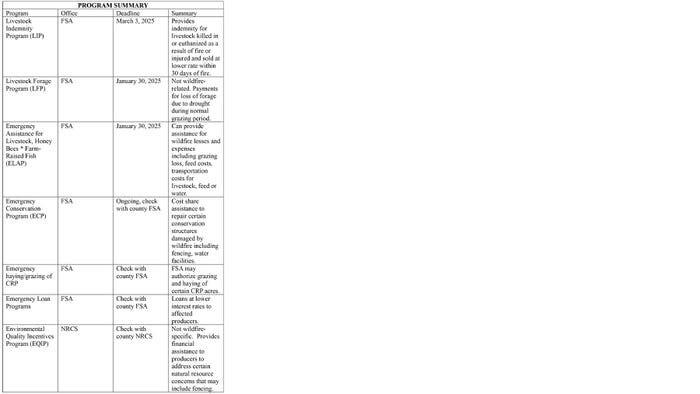March 19, 2024

The damage and devastation left in the wake of the Panhandle wildfires is unimaginable and will continue to impact landowners, agricultural producers, families, and communities for years to come. As those impacted begin to rebuild, there are resources available to help.
USDA Programs
There are a number of programs through the United States Department of Agriculture Farm Service Agency (FSA) that may be available to assist producers who have suffered losses of land, livestock, and fences due to the fires. We have a podcast episode and video walking through each of these programs as well. We also did this prior podcast episode on working with the local FSA office.
Here is a brief overview of the programs affected landowners and livestock producers might ask about at their local FSA office. The staff at the local FSA office will be able to provide far more information and details on each program and help determine potential eligibility.
Livestock Indemnity Program: LIP provides assistance for livestock losses due to disaster, including wildfire. LIP provides indemnity payments for livestock killed in the fires, for livestock that had to be euthanized as a direct result of the fires, and for livestock injured by the wildfire that are sold for a reduced rate within 30 days. The payment rate for 2024 losses will be released later this month. Producers will need to provide record of their losses that may include inventories, financial records, photographs, rendering receipts, and veterinary certifications. FSA is encouraging producers to document dead or injured animals with photographs that are dated, and for calves, to estimate the weight of the animal as well. The deadline to provide notice of loss and an application for payment is 60 days after the calendar year in which the loss occurred, which would be March 1, 2025.
Livestock Forage Program: LFP is not specifically wildfire-related. Instead, it is designed to provide assistance to livestock producers with grazed forage acres that have suffered grazing loss due to drought during the normal grazing period. Thus, producers may qualify for LPF payments if there is a drought declared in their area. The 2024 LFP payment rates will be released in April. The deadline to apply for LFP for 2024 losses is January 30, 2025.
Emergency Assistance for Livestock, Honey Bees & Farm-Raised Fish: ELAP assists with a variety of losses related to wildfire including certain grazing losses, feed costs, and transportation of livestock, feed, and water. Producers have until January 30, 2025, to apply for ELAP.
Emergency Conservation Program: ECP provides cost-share assistance to repair or replace certain conservation structures damaged by wildfire. Qualifying structures may include fences and watering facilities. The ECP cost-share is 90% for underserved producers and 75% for all other producers. ECP has an ongoing, localized deadline, so landowners should check with their local FSA office for more information.
Emergency haying/grazing of CRP acres: The FSA may authorize emergency haying and/or grazing of CRP acres to support areas impacted by wildfire including the relocation of livestock for grazing purposes. The details on where and when this may be available differ by county, so producers should contact the local FSA office for additional details.
Emergency Loan Programs: The FSA has an emergency loan program offering loans to affected producers at an interest rate generally lower than other lenders. The requirements and details of these loan programs are available at the local FSA office.
Environmental Quality Incentives Program: EQIP is administered by the Natural Resources Conservation Services office and offers financial assistance to landowners to address certain natural resource concerns. This program is not disaster specific but could potentially be an option for producers seeking to implement certain conservation practices. In some instances, building fences may qualify for EQIP funding. Recently, the USDA announced a specific $6 million in EQIP funding specifically for Panhandle producers and landowners impacted by the fires. Critically, the application deadline for this particular $6-million pool of money is April 8, 2024.
Texas A&M AgriLife Extension Resources
Texas A&M AgriLife Extension has been hard at work since the fires started to provide resources and assistance in impacted communities. This includes operating supply points where affected producers can obtain donated hay, feed, milk replacer, and fencing supplies. For more information on the AgriLife efforts and where to contribute, click here. We also did a podcast episode featuring Dr. Monty Dozier highlighting these efforts.
Texas A&M AgriLife Extension Mental Health Resources
Additionally, we have a podcast episode and video outlining mental health tips and resources after a disaster. Miquela Smith, MPH, joined us to walk us through how to care for our own mental health and to remind us the importance of watching out for our friends and neighbors during this time. Read more here.
Additional Resources
A number of other groups have developed resources as well.
The Texas & Southwestern Cattle Raisers Association has a Disaster Relief Fund to provide funding to producers in Texas and Oklahoma who are impacted by natural disasters. Producers are not required to be TSCRA members to apply. Applications must be filed within 60 days of the damage. For more information, click here.
The Texas Department of Agriculture administers the STAR fund, designed to assist producers damaged by natural disasters. Producers may apply for assistance with expenses not covered by insurance or other governmental sources. For more information, click here.

About the Author(s)
You May Also Like




